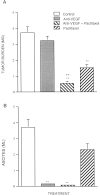Vascular endothelial growth factor immunoneutralization plus Paclitaxel markedly reduces tumor burden and ascites in athymic mouse model of ovarian cancer
- PMID: 12414537
- PMCID: PMC1850791
- DOI: 10.1016/S0002-9440(10)64467-7
Vascular endothelial growth factor immunoneutralization plus Paclitaxel markedly reduces tumor burden and ascites in athymic mouse model of ovarian cancer
Abstract
Ovarian cancer is characterized by rapid growth of solid intraperitoneal tumors and production of large volumes of ascites. Our previous studies of intraperitoneal ovarian carcinoma in an athymic mouse model demonstrated that a monoclonal antibody (mAb) to human vascular endothelial growth factor (VEGF) could prevent ascites formation. Although ascites was almost completely inhibited, tumor burden was variably reduced. To develop more effective therapy, we assessed the combination of a human VEGF mAb plus paclitaxel. Four groups of female athymic nude mice were inoculated intraperitoneally with OVCAR3 cells. Two weeks after inoculation, one group was treated with a human VEGF mAb intraperitoneally twice weekly plus paclitaxel intraperitoneally three times weekly for 6 weeks. The second group was treated with VEGF mAb alone. The third group was treated with paclitaxel alone. The remaining group was treated with vehicle only. Tumor burden in the VEGF mAb plus paclitaxel and paclitaxel alone groups was reduced by 83.3% and 85.7% and 58.5% and 59.5%, respectively, in two separate experiments, compared to controls. VEGF mAb alone caused no significant decrease in tumor burden, nor did treatment of mice inoculated intraperitoneally with HEY-A8 cells, a non-VEGF-secreting ovarian cell line. Virtually no ascites developed in the combined treatment group or the group treated with VEGF mAb alone. Paclitaxel alone reduced ascites slightly, but not significantly. Morphological studies demonstrated that VEGF immunoneutralization enhanced paclitaxel-induced apoptosis in these human ovarian cancers. Thus, combination therapy with inhibitors of VEGF plus paclitaxel may be an effective way to markedly reduce tumor growth and ascites in ovarian carcinoma.
Figures




References
-
- Cannistra SA: Cancer of the ovary. N Engl J Med 1993, 329:1550-1559 - PubMed
-
- Connolly DT, Olander JV, Heuvelman D, Nelson R, Monsell R, Siegel N, Haymore BL, Leimgruber R, Feder J: Human vascular permeability factor. Isolation from U937 cells. J Biol Chem 1989, 264:20017-20024 - PubMed
-
- Nagy JA, Masse EM, Herzberg KT, Meyers MS, Yeo KT, Yeo TK, Sioussat TM, Dvorak HF: Pathogenesis of ascites tumor growth: vascular permeability factor, vascular hyperpermeability, and ascites fluid accumulation. Cancer Res 1995, 55:360-368 - PubMed
-
- Barton DP, Cai A, Wendt K, Young M, Gamero A, DeCesare S: Angiogenic protein expression in advanced epithelial ovarian cancer. Clin Cancer Res 1997, 3:1579-1586 - PubMed
-
- Kraft A, Weindel K, Ochs A, Marth C, Zmija J, Schumacher P, Unger C, Marme D, Gastl G: Vascular endothelial growth factor in the sera and effusions of patients with malignant and nonmalignant disease. Cancer 1999, 85:178-187 - PubMed
Publication types
MeSH terms
Substances
Grants and funding
LinkOut - more resources
Full Text Sources
Other Literature Sources
Medical

